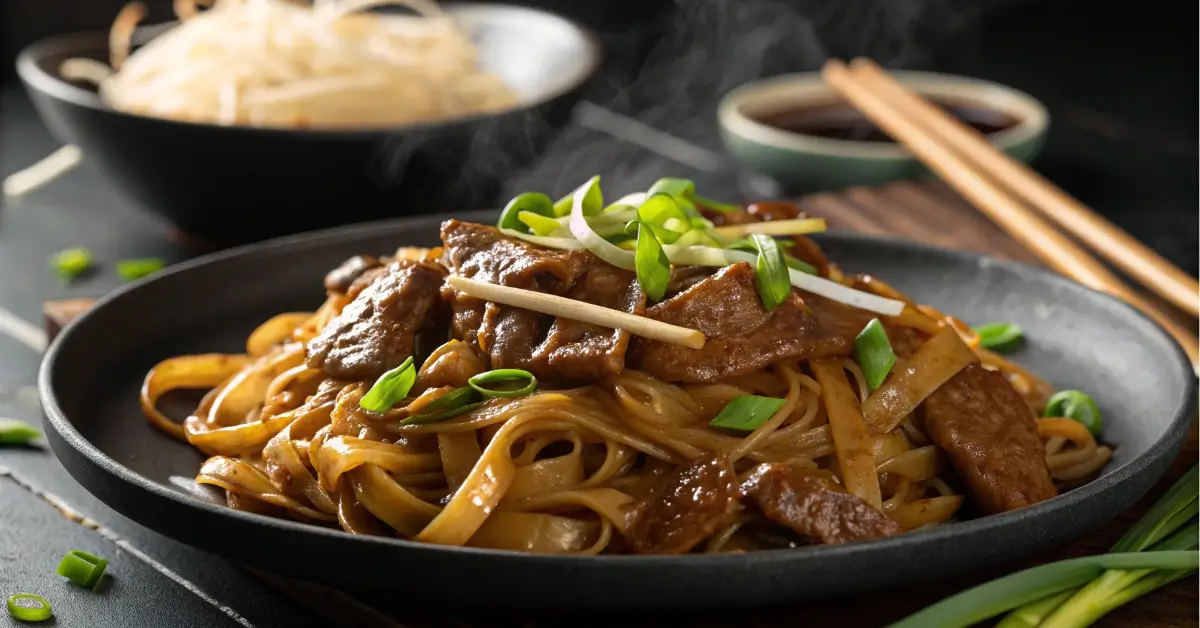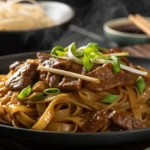Chow fun is one of the most beloved dishes in Chinese cuisine, offering a satisfying medley of chewy wide rice noodles stir-fried with savory sauces, tender meats, and crisp vegetables. Whether you’ve seen it on a takeout menu or tasted it at an authentic Cantonese restaurant, there’s a rich history and technique behind this seemingly simple dish. In this comprehensive guide, you’ll learn everything from the origins of chow fun to how to cook a restaurant-quality version at home, explore healthy variations, compare it with dishes like lo mein and pad see ew, and even uncover expert cooking tips like mastering the wok hei flavor. Don’t miss our blog with more tasty inspiration to take your noodle game to the next level.
Jumo to:
What Is Chow Fun? Understanding the Origins
The History of Chow Fun Noodles
Chow fun (炒粉), translating literally to “fried noodles,” hails from the Cantonese-speaking regions of southern China, especially Guangdong and Hong Kong. The dish dates back to traditional street food stalls, where cooks stir-fried flat, wide rice noodles in sizzling hot woks to create fast, flavorful meals. The method was a way to use up leftover ingredients, making it an efficient and delicious everyday option.
These wide rice noodles, known as hor fun (河粉), are typically made from rice flour and water, resulting in their signature smooth texture and ability to soak up sauces beautifully. Chow fun has since evolved and traveled across Asia and Western countries, becoming a menu staple in Chinese-American cuisine.
Cantonese Roots and Culinary Evolution
In traditional Cantonese cooking, simplicity and technique shine. Chow fun is no different. One of the defining features is the “wok hei,” which translates to “breath of the wok.” This smoky, charred essence is achieved by stir-frying noodles at extremely high temperatures—a hallmark of authentic Cantonese cuisine.
Over time, the dish diversified. From classic beef chow fun to chicken, shrimp, tofu, or mixed vegetable versions, every variation maintains the core identity: glossy, stir-fried rice noodles balanced with protein and green onions or bean sprouts. Chow fun has now found a place not just in restaurants but also in home kitchens, thanks to its quick preparation and crowd-pleasing flavors.
Chow Fun vs. Other Noodle Dishes
Chow Fun vs. Lo Mein: What’s the Real Difference?
Chow fun and lo mein are both noodle-based dishes beloved in Chinese cuisine, but they couldn’t be more different in texture, preparation, and flavor. The key difference lies in the type of noodle and how it’s cooked. Chow fun uses wide, flat rice noodles, while lo mein features round wheat noodles, similar to spaghetti.
When preparing chow fun, the rice noodles are stir-fried directly in a wok, often at high heat to achieve that elusive wok hei flavor. Lo mein noodles, on the other hand, are boiled first, then tossed with sauce and ingredients. This gives lo mein a softer, chewier texture, whereas chow fun’s rice noodles soak up sauces differently and have a more slippery bite.
Flavor-wise, chow fun tends to be smokier and richer, especially when made with beef or shrimp. Lo mein leans sweeter and saucier, often drenched in soy-based or oyster sauces. Curious about comfort food fusion? Discover great ideas like our slow-cooker cube steak recipe to expand your palate.
Chow Fun vs. Pad See Ew: Chinese vs Thai Styles
While both dishes use wide rice noodles, chow fun and pad see ew differ in cuisine origins, flavor profiles, and ingredients. Chow fun comes from Cantonese cuisine and uses minimal seasoning—mainly soy sauce, Shaoxing wine, and sometimes black bean paste for depth.
Pad see ew is a Thai street food classic. It’s seasoned more aggressively, with dark soy sauce, fish sauce, sugar, and garlic. The dish often includes Chinese broccoli (gai lan) and is slightly sweeter, balancing umami with caramelized edges from the pan.
One hallmark of chow fun is its lighter, more savory tone, allowing the natural flavors of beef or vegetables to shine through. In contrast, pad see ew delivers bolder, slightly charred flavors and often more oil.
Here’s a quick comparison table:
| Feature | Chow Fun | Pad See Ew |
|---|---|---|
| Cuisine Origin | Chinese (Cantonese) | Thai |
| Noodles | Wide rice noodles (hor fun) | Wide rice noodles |
| Key Flavors | Savory, smoky (wok hei) | Sweet, umami, caramelized |
| Common Ingredients | Beef, bean sprouts | Chicken/pork, Chinese broccoli |
| Cooking Technique | Stir-fried in hot wok | Pan-fried with soy sauces |
Looking for inspiration? Try our crispy salmon bites air fryer guide to master quick pan-frying like a pro.
Types of Chow Fun Noodles
Fresh Wide Rice Noodles (Hor Fun): Explained
At the heart of every authentic chow fun dish lies the wide rice noodle, commonly known as hor fun or ho fun. These flat, slippery noodles are made from a simple mix of rice flour, water, and sometimes tapioca starch, giving them a smooth, chewy texture that sets chow fun apart from other stir-fried noodles.
You can find hor fun fresh at Asian grocery stores in the refrigerated section. They often come in large sheets or loosely packed strips. Fresh noodles are ideal for stir-frying, as they absorb flavors quickly and develop a light char when cooked over high heat.
If fresh noodles aren’t available, dried versions can work too. Just be sure to soak them in warm water and steam or lightly boil them until they soften. The key is avoiding overcooking—they should be tender but still have bite.
Chow fun noodles are gluten-free, making them a fantastic option for those with dietary restrictions. They’re also versatile and can be used in soups, salads, or other Asian dishes beyond traditional chow fun.
Dry vs. Wet Chow Fun: Stir-Fry or Gravy-Style
There are two primary ways to enjoy chow fun—dry stir-fried or wet gravy-style, and each offers a different taste experience.
- Dry Chow Fun (Gan Chow Fun)
This is the most common version, especially the famous beef chow fun, where noodles are seared at high heat until lightly crispy. This method is all about wok hei, giving the dish its signature smoky flavor. Ingredients like soy sauce, sesame oil, and garlic are used sparingly to let the ingredients shine. - Wet Chow Fun (Wat Dan Hor)
Popular in Malaysia and Singapore, this version features noodles smothered in a silky egg-based gravy, usually made with chicken or seafood stock, cornstarch, egg, and light seasoning. It’s comforting, hearty, and more like a noodle stew than a dry stir-fry.
Here’s a quick breakdown:
| Style | Description | Common Proteins | Texture Profile |
|---|---|---|---|
| Dry Chow Fun | Stir-fried with minimal sauce | Beef, shrimp | Smoky, slightly crispy |
| Wet Chow Fun | Noodles in savory egg-based gravy | Chicken, seafood | Silky, soft, saucy |
For a sweet balance to your stir-fry feast, don’t miss our Starbucks banana nut bread recipe—perfect for dessert!
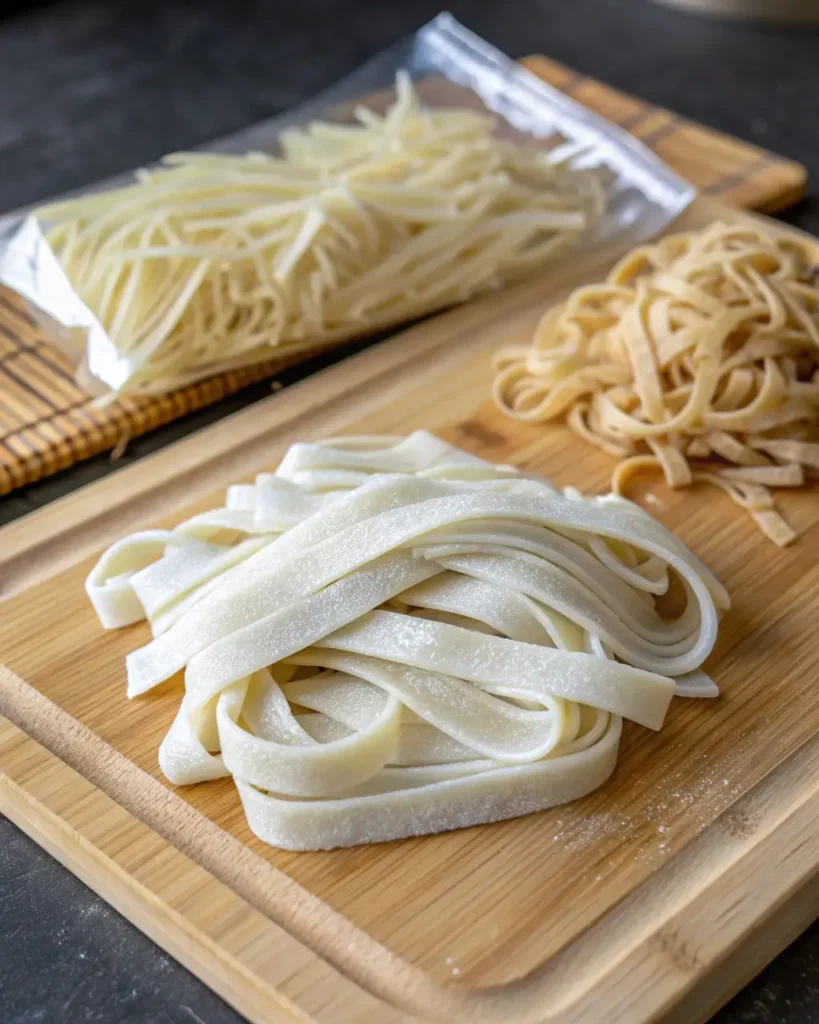
Classic Beef Chow Fun Recipe
Key Ingredients You Need
To make authentic beef chow fun at home, simplicity is key. This dish doesn’t rely on an overload of ingredients—just fresh, quality components and the right stir-fry technique.
Here’s what you’ll need:
| Ingredient | Quantity | Notes |
|---|---|---|
| Wide rice noodles (hor fun) | 12 oz (fresh) | Fresh preferred; if dried, soak & steam first |
| Beef (flank or skirt steak) | 8 oz | Thinly sliced across the grain |
| Soy sauce (light + dark) | 2 tbsp total | Dark soy for color, light for saltiness |
| Shaoxing wine | 1 tbsp | Adds depth; substitute dry sherry if needed |
| Sesame oil | 1 tsp | For a nutty aroma |
| Garlic | 2 cloves, minced | Enhances the stir-fry base |
| Bean sprouts | 1 cup | Adds crunch and freshness |
| Green onions | 3 stalks, chopped | Use both white and green parts |
| Cornstarch | 1 tsp | For marinating the beef |
| Oil (peanut or canola) | 2 tbsp | For high-heat cooking |
Optional: Add a dash of oyster sauce or fermented black bean paste for extra umami.
Step-by-Step Cooking Instructions
Step 1: Prep the beef
Thinly slice the beef and toss it in a bowl with 1 tsp soy sauce, 1 tsp Shaoxing wine, and 1 tsp cornstarch. Let it marinate for 15 minutes while you prepare the other ingredients.
Step 2: Loosen the noodles
If using fresh noodles, gently separate them. If they’re cold or clumped, steam for a few minutes or microwave with a damp towel until soft. For dried noodles, soak according to the package, then drain.
Step 3: Sear the beef
Heat 1 tbsp oil in a smoking hot wok or skillet. Add beef in a single layer. Don’t stir immediately. Let it sear for about 1 minute, then flip and finish cooking. Remove and set aside.
Step 4: Stir-fry the aromatics
Add another tbsp oil to the same wok. Toss in minced garlic and the white part of the green onions. Stir quickly until fragrant—about 10 to 15 seconds.
Step 5: Add noodles and sauce
Spread the noodles in the wok. Pour in your soy sauces, Shaoxing wine, and sesame oil. Use tongs to lift and toss the noodles gently. This helps coat them evenly without breaking.
Step 6: Finish with beef and veggies
Return the beef to the wok. Add bean sprouts and the green onion tops. Stir-fry everything for another 1–2 minutes until the noodles are glossy and everything is heated through.
Step 7: Serve hot
Dish up right away. Chow fun is best when served immediately—hot, smoky, and loaded with flavor.
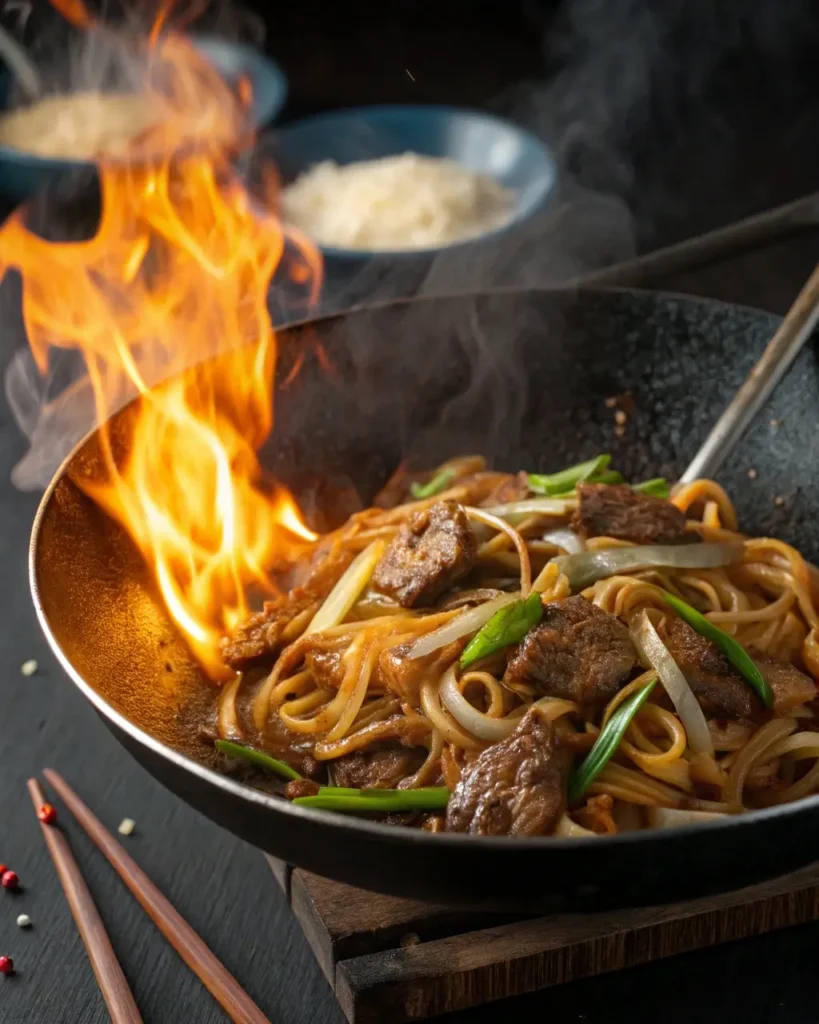
Regional Chow Fun Variations
Singapore-Style Chow Fun
Although chow fun is traditionally Cantonese, it’s gained global popularity with unique regional twists. Singapore-style chow fun is one such flavorful spin. This version blends spicy Southeast Asian influences with classic Chinese stir-fry technique.
Often known locally as Singapore rice noodles (though technically a mislabel, since they’re made with vermicelli), this take on chow fun uses curry powder, chili sauce, and colorful vegetables to create a vibrant, spiced dish. The base protein might be shrimp, chicken, or char siu pork, and it’s typically loaded with bell peppers, onions, and cabbage.
What makes it chow fun-like is the stir-fry method and bold seasoning, paired with that same satisfying noodle texture. It’s a great option for fans of heat and umami.
| Feature | Singapore-Style Chow Fun |
|---|---|
| Noodles | Sometimes vermicelli or hor fun |
| Signature Ingredient | Curry powder or sambal |
| Common Proteins | Char siu pork, shrimp, egg |
| Flavor Profile | Spicy, slightly sweet, savory |
This version’s exciting, fusion-style approach is perfect for adventurous eaters. And if you’re into bold flavors, check out our guide to flavor-packed chicken & shrimp stir-fry.
American Chinese Chow Fun: Takeout Influence
In the U.S., beef chow fun became a staple of American Chinese takeout. Its popularity soared thanks to its meaty richness and noodle satisfaction, paired with the deep umami flavor of soy-based sauces.
In takeout versions, the flavors are often slightly sweet and garlicky, and vegetables like onions, bell peppers, or broccoli might be added for bulk and crunch. While it may lack the wok hei of traditional cooking, American chow fun wins with its hearty portions and crowd-pleasing taste.
It’s also common to find these versions labeled as:
- Beef Ho Fun
- House Special Chow Fun (with mixed proteins)
- Shrimp Chow Fun
Some restaurants even offer a spicy Szechuan version or a black bean sauce variant, adding depth to the traditional flavor profile. These adjustments reflect local tastes and ingredient availability.
Chow fun’s flexibility is a big part of its global success—and why it’s a favorite on dinner tables from Hong Kong to Houston.
Vegetarian & Healthy Chow Fun Alternatives
Vegetable Chow Fun: Plant-Based Variation
Chow fun isn’t just for meat lovers—vegetable chow fun is a vibrant, satisfying option that packs all the flavor without the meat. This version replaces beef or pork with a colorful medley of crisp vegetables, offering the same texture and wok hei magic while being entirely plant-based.
Some of the best veggies for chow fun include:
- Broccoli florets
- Snow peas
- Carrots (julienned)
- Mushrooms (shiitake or cremini)
- Baby corn
- Bell peppers
You can also add tofu (pan-fried or crispy air-fried) for a protein boost. Marinate the tofu in soy sauce, garlic, and sesame oil for extra flavor before cooking.
The sauce remains simple: soy sauce, sesame oil, garlic, and a splash of vegetable broth or hoisin sauce for depth. A few chili flakes can heat things up if you like it spicy.
| Ingredient | Health Benefit |
|---|---|
| Broccoli | Rich in fiber, vitamin C, and iron |
| Mushrooms | Low-cal, packed with antioxidants |
| Carrots | High in beta-carotene and fiber |
| Tofu | High-protein, low-fat meat alternative |
Vegetarian chow fun is fast, healthy, and completely satisfying—perfect for meatless Mondays or a quick dinner fix.
Is Chow Fun Healthy? Nutrition Breakdown
Let’s break down the health profile of chow fun to see how it fits your lifestyle.
| Nutritional Element | Approx. Value (1 serving beef chow fun) |
|---|---|
| Calories | ~450–600 kcal |
| Carbohydrates | 50–60g |
| Protein | 20–25g (from beef/tofu) |
| Fat | 15–20g (depending on oil used) |
| Fiber | 3–5g (with added vegetables) |
| Sodium | Medium–high (depends on soy sauces) |
Chow fun can be healthy when prepared mindfully. Use less oil, opt for lean proteins, and pile on the veggies. Choosing low-sodium soy sauce and avoiding deep-fried components also keeps things balanced.
Going gluten-free? You’re in luck—rice noodles are naturally gluten-free, so with the right sauce (tamari or coconut aminos), chow fun is totally gluten-free friendly.
Looking for other health-forward meals? Don’t miss our almond cake recipe with almond meal—a wholesome, delicious dessert option.
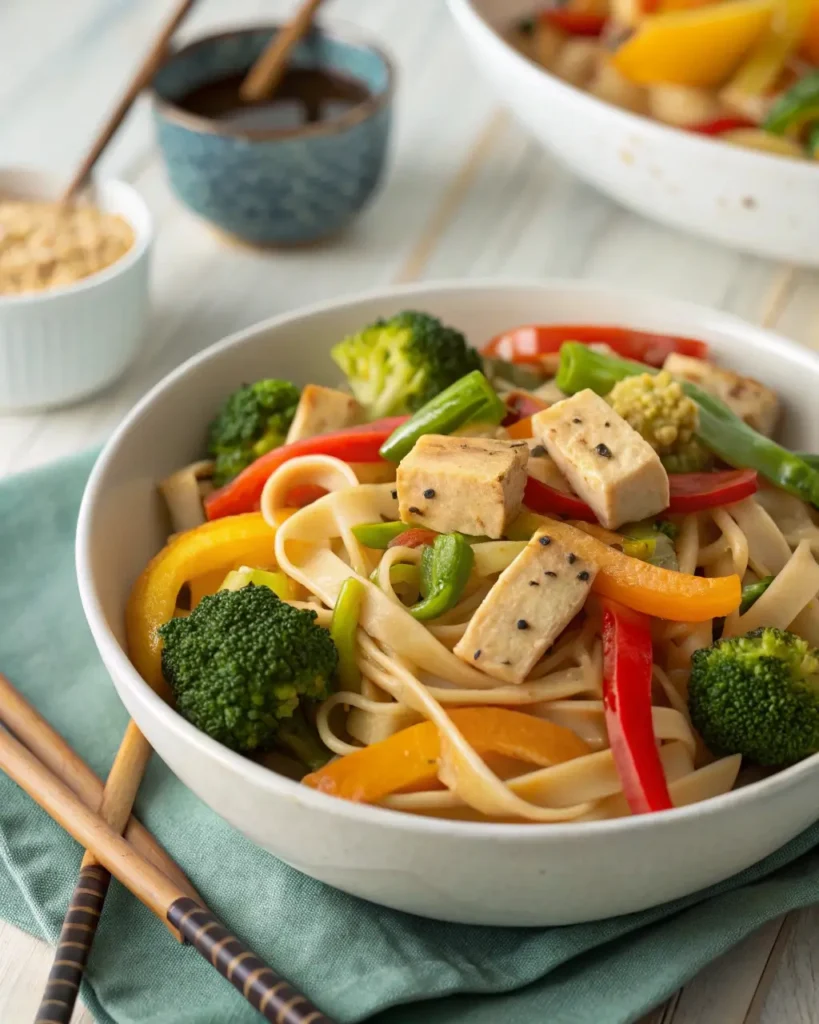
Cooking Techniques & Pro Tips
Wok Hei: The Secret to Authentic Chow Fun
Ask any Cantonese chef and they’ll tell you: “Wok hei” is the soul of chow fun. Translated as the “breath of the wok,” this flavor comes from high-temperature searing that creates smoky, caramelized, umami-rich undertones.
To achieve wok hei at home:
- Use a carbon steel wok – it heats quickly and retains heat evenly.
- Preheat the wok until it smokes lightly before adding oil. This is essential.
- Cook in small batches. Crowding the pan causes steaming, not frying.
- Keep ingredients dry—especially the noodles. Wet ingredients kill wok hei.
Pro tip: Once you add the noodles, let them sear for 20–30 seconds before stirring. That crispy, golden edge? That’s wok hei magic happening.
Even with a home stove, a smoking-hot wok, dry ingredients, and quick cooking will bring you close to restaurant-quality chow fun.
Preventing Sticky Noodles: Pro-Level Hacks
Sticky noodles can ruin the whole dish. Want those silky, separated strands instead of a gummy mess? Follow these must-know hacks:
- Steam fresh noodles briefly if they’re clumped. This loosens them up without breaking.
- Oil your noodles lightly before stir-frying to keep them from sticking together.
- Use a wide spatula or tongs to gently turn noodles instead of mixing vigorously.
- Cook noodles separately if you’re using dried or fresh-but-refrigerated ones, then add them last.
Remember, rice noodles are delicate. The goal is to stir-fry, not scramble. Keep the heat high and the tosses gentle.
If you’re already loving this savory journey, don’t miss our comforting Alice’s Spring Chicken recipe—a cheesy favorite made for cozy nights in.
How to Customize Your Chow Fun at Home
Best Proteins and Vegetables to Mix In
One of the most amazing things about chow fun is how incredibly adaptable it is. You can switch up the protein, toss in your favorite vegetables, and even go fully plant-based—all while keeping that iconic chewy, saucy, wok-fried vibe intact.
Popular Protein Options:
- Chicken – Thinly sliced thighs or breasts marinated in soy sauce and garlic.
- Shrimp – Deveined and tossed in sesame oil and a pinch of cornstarch.
- Pork – Char siu (Chinese BBQ pork) adds sweetness and depth.
- Tofu – Pan-seared or air-fried for a crispy edge that holds up in stir-fry.
- Egg – Scrambled directly in the wok for a classic touch.
Top Vegetables for Chow Fun:
- Bell peppers (colorful and sweet)
- Snap peas or snow peas (crunchy)
- Napa cabbage or bok choy (soft with bite)
- Mushrooms (meaty and savory)
- Green beans or zucchini (light and fresh)
Don’t be afraid to mix and match. Chow fun is a dish that welcomes creativity.
Here’s a quick substitution matrix:
| Protein Type | Flavor Profile | Cooking Tip |
|---|---|---|
| Chicken | Mild, juicy | Marinate in soy & garlic, cook fully |
| Shrimp | Sweet, firm | Cook quickly to avoid rubberiness |
| Pork | Rich, slightly sweet | Use char siu or roast pork |
| Tofu | Neutral, nutty | Pan-fry until golden before adding |
| Egg | Savory, creamy | Scramble before adding noodles |
Making Chow Fun Gluten-Free or Low-Sodium
Trying to make chow fun healthier or allergen-friendly? It’s easier than you think.
Gluten-Free Tips:
- Rice noodles = naturally gluten-free.
- Replace soy sauce with tamari or coconut aminos (less salty, gluten-free).
- Use gluten-free hoisin or black bean sauces if adding depth.
Low-Sodium Tips:
- Choose low-sodium soy sauce.
- Increase garlic, ginger, and sesame oil for natural flavor.
- Add a splash of rice vinegar or citrus to brighten taste without salt.
If you’re watching your carb intake, consider replacing the rice noodles with:
- Zucchini noodles (zoodles)
- Kelp noodles
- Shirataki noodles
They won’t give you the same chewy texture as hor fun, but they’ll work well in a stir-fry base—and still soak up sauce beautifully.
Looking to mix things up? Explore our chicken and cabbage stir-fry—another customizable, veggie-forward dish that’s perfect for weeknights.
Where to Buy Chow Fun Noodles & Storage Tips
Asian Grocery Store Guide
Finding authentic chow fun noodles is easier than ever, especially if you know where to look. Most Asian supermarkets carry wide rice noodles—both fresh and dried.
Where to buy:
- H Mart (USA-wide Korean chain)
- 99 Ranch Market (West Coast + online)
- Local Asian markets (Chinese or Thai specialty stores)
- Online stores like Yamibuy, Weee!, and Amazon (look for “fresh hor fun” or “wide rice noodles”)
When shopping, aim for:
- Fresh rice noodles: Soft, pliable, refrigerated. Often packed in sheets or strips.
- Dried rice noodles: Choose wide-cut varieties labeled as “rice sticks” or “bánh phở.”
Always check the label—some noodles are labeled “pad see ew noodles” or “pho noodles,” which can be swapped in if needed.
Pro tip: If the noodles are clumped in the pack, don’t panic. Gently steam or microwave them with a damp paper towel to loosen without breaking.
Storage, Reheating, and Meal Prep Ideas
Leftover chow fun? Here’s how to keep it tasty.
Storage Tips:
- Store in an airtight container in the fridge for up to 3 days.
- Avoid freezing fresh rice noodles—they can turn mushy upon thawing.
Reheating Tips:
- Best method: Pan-fry with a splash of water or soy sauce over medium-high heat.
- Microwave: Add a damp paper towel over the container to retain moisture. Reheat in 30-second bursts, tossing in between.
Meal Prep Ideas:
- Cook your proteins and veggies separately.
- Store sauce and noodles in different containers to avoid sogginess.
- Reheat everything together in a wok or large skillet for a “fresh-cooked” texture.
Looking for easy lunch ideas? Don’t miss our chicken and dressing guide—perfect for prepping ahead!
FAQs: Answering Popular Chow Fun Questions
What is chow fun vs Lo Mein?
Chow fun uses wide, flat rice noodles stir-fried quickly at high heat, often with beef or vegetables, creating a smoky wok hei flavor. Lo mein, on the other hand, uses wheat-based egg noodles that are boiled and then tossed with sauces. The key difference lies in the noodle type and cooking method—chow fun is stir-fried directly, while lo mein is cooked and then mixed.
What is in Chinese chow fun?
Traditional Chinese chow fun contains:
Wide rice noodles (hor fun)
Protein (beef, chicken, shrimp, or tofu)
Bean sprouts and green onions
Garlic and soy sauce
Sometimes a splash of Shaoxing wine and sesame oil for aroma
Optional additions include onions, bell peppers, and mushrooms, depending on the region or chef’s twist.
What’s the difference between chow fun and Pad See Ew?
Both dishes use wide rice noodles, but chow fun is Cantonese and Pad See Ew is Thai. Chow fun focuses on smoky umami flavors with beef or tofu, while Pad See Ew includes dark soy sauce, sugar, garlic, and Chinese broccoli. Pad See Ew tends to be sweeter and more caramelized, whereas chow fun is saltier and more savory.
Are chow fun noodles healthy?
Chow fun can be healthy when cooked mindfully. Rice noodles are gluten-free, and the dish can be loaded with vegetables and lean protein. Limit oil and soy sauce for a lighter version. Opt for plant-based protein and low-sodium soy for added benefits. On average, a serving contains 450–600 calories.
Which is tastier, lo mein or chow mein?
Taste is subjective, but chow fun is often considered more flavorful because of the wok hei technique. Lo mein is softer and saucier, while chow mein (not to be confused with chow fun) is either stir-fried or crispy. Chow fun stands out for its bold, smoky, savory essence and slippery noodle texture.
What are the crunchy Chinese noodles called?
Those are typically called crispy chow mein noodles or fried wonton strips. They’re made from egg noodles that are fried until golden and crisp. While not used in chow fun, they often appear as garnishes or in American Chinese cuisine as crunchy toppings for soups or salads.
Conclusion: Mastering Chow Fun at Home
Whether you’re a home chef or a takeout enthusiast, chow fun offers an exciting journey into Cantonese culinary tradition. With its smoky wok hei flavor, tender rice noodles, and versatile ingredients, this dish checks all the boxes: flavor, simplicity, and cultural richness. You’ve now got everything you need—from recipe techniques and customization ideas to healthy swaps and noodle-buying tips—to stir-fry like a pro.
Want more delicious dishes to explore? Check out more great recipes on the blog or try your hand at this southern-style chicken and dressing.
PrintBeef Chow Fun
Savory and smoky Cantonese stir-fried wide rice noodles with tender beef, garlic, and green onions. This classic chow fun recipe is quick, flavorful, and easy to customize.
- Prep Time: 15 minutes
- Cook Time: 10 minutes
- Total Time: 25 minutes
- Yield: 2 servings
- Category: Dinner, Main Course
- Method: Stir-Fry
- Cuisine: Chinese, Cantonese
- Diet: Gluten Free
Ingredients
- 12 oz fresh wide rice noodles (hor fun)
- 8 oz flank steak, thinly sliced across the grain
- 2 tbsp soy sauce (1 tbsp light, 1 tbsp dark)
- 1 tbsp Shaoxing wine (or dry sherry)
- 1 tsp sesame oil
- 2 garlic cloves, minced
- 1 cup bean sprouts
- 3 green onions, chopped (separate whites and greens)
- 1 tsp cornstarch (for marinating beef)
- 2 tbsp peanut or canola oil
- Optional: oyster sauce or fermented black bean paste
Instructions
- Marinate the Beef: In a small bowl, combine beef with 1 tsp soy sauce, 1 tsp Shaoxing wine, and 1 tsp cornstarch. Let it sit for 15 minutes.
- Prep Noodles: If using fresh noodles, gently separate them. Steam briefly if clumped. For dried noodles, soak and drain as per package.
- Cook the Beef: Heat 1 tbsp oil in a wok until smoking. Sear beef slices in a single layer. Cook for 1–2 minutes, then set aside.
- Stir-Fry Aromatics: Add another tbsp oil. Stir-fry garlic and white parts of green onions until fragrant.
- Add Noodles & Sauce: Add noodles to the wok. Pour in remaining soy sauces, wine, and sesame oil. Toss gently.
- Combine & Finish: Return beef to the wok. Add bean sprouts and green onion tops. Stir-fry for 1–2 more minutes until hot.
- Serve Immediately: Plate hot for best texture and flavor.
Notes
- For a spicier version, add chili flakes or a drizzle of chili oil.
- Substitute tofu for beef for a vegetarian option.
- Achieve wok hei by ensuring your wok is very hot and ingredients are dry.

